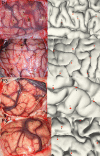Automatic and Precise Localization and Cortical Labeling of Subdural and Depth Intracranial Electrodes
- PMID: 28261083
- PMCID: PMC5314105
- DOI: 10.3389/fninf.2017.00010
Automatic and Precise Localization and Cortical Labeling of Subdural and Depth Intracranial Electrodes
Abstract
Object: Subdural or deep intracerebral electrodes are essential in order to precisely localize epileptic zone in patients with medically intractable epilepsy. Precise localization of the implanted electrodes is critical to clinical diagnosing and treatment as well as for scientific studies. In this study, we sought to automatically and precisely extract intracranial electrodes using pre-operative MRI and post-operative CT images. Method: The subdural and depth intracranial electrodes were readily detected using clustering-based segmentation. Depth electrodes were tracked by fitting a quadratic curve to account for potential bending during the neurosurgery. The identified electrodes can be manipulated using a graphic interface and labeled to cortical areas in individual native space based on anatomical parcellation and displayed in the volume and surface space. Results: The electrodes' localizations were validated with high precision. The electrode coordinates were normalized to a standard space. Moreover, the probabilistic value being to a specific area or a functional network was provided. Conclusions: We developed an integrative toolbox to reconstruct and label the intracranial electrodes implanted in the patients with medically intractable epilepsy. This toolbox provided a convenient way to allow inter-subject comparisons and relation of intracranial EEG findings to the larger body of neuroimaging literature.
Keywords: ECoG; SEEG; electrode localization; intracranial EEG; intractable epilepsy.
Figures








Similar articles
-
Modeling intracranial electrodes. A simulation platform for the evaluation of localization algorithms.Front Neuroinform. 2022 Oct 6;16:788685. doi: 10.3389/fninf.2022.788685. eCollection 2022. Front Neuroinform. 2022. PMID: 36277477 Free PMC article.
-
iElectrodes: A Comprehensive Open-Source Toolbox for Depth and Subdural Grid Electrode Localization.Front Neuroinform. 2017 Mar 2;11:14. doi: 10.3389/fninf.2017.00014. eCollection 2017. Front Neuroinform. 2017. PMID: 28303098 Free PMC article.
-
Anatomical registration of intracranial electrodes. Robust model-based localization and deformable smooth brain-shift compensation methods.bioRxiv [Preprint]. 2023 May 11:2023.05.08.539503. doi: 10.1101/2023.05.08.539503. bioRxiv. 2023. Update in: J Neurosci Methods. 2024 Apr;404:110056. doi: 10.1016/j.jneumeth.2024.110056. PMID: 37214984 Free PMC article. Updated. Preprint.
-
Presurgical intracranial investigations in epilepsy surgery.Handb Clin Neurol. 2019;161:45-71. doi: 10.1016/B978-0-444-64142-7.00040-0. Handb Clin Neurol. 2019. PMID: 31307620 Review.
-
Stereoelectroencephalography: Indication and Efficacy.Neurol Med Chir (Tokyo). 2017 Aug 15;57(8):375-385. doi: 10.2176/nmc.ra.2017-0008. Epub 2017 Jun 20. Neurol Med Chir (Tokyo). 2017. PMID: 28637943 Free PMC article. Review.
Cited by
-
Integrated analysis of anatomical and electrophysiological human intracranial data.Nat Protoc. 2018 Jul;13(7):1699-1723. doi: 10.1038/s41596-018-0009-6. Nat Protoc. 2018. PMID: 29988107 Free PMC article.
-
Theta oscillations synchronize human medial prefrontal cortex and amygdala during fear learning.Sci Adv. 2021 Aug 18;7(34):eabf4198. doi: 10.1126/sciadv.abf4198. Print 2021 Aug. Sci Adv. 2021. PMID: 34407939 Free PMC article.
-
Theta oscillations coordinate grid-like representations between ventromedial prefrontal and entorhinal cortex.Sci Adv. 2021 Oct 29;7(44):eabj0200. doi: 10.1126/sciadv.abj0200. Epub 2021 Oct 27. Sci Adv. 2021. PMID: 34705507 Free PMC article.
-
Modeling intracranial electrodes. A simulation platform for the evaluation of localization algorithms.Front Neuroinform. 2022 Oct 6;16:788685. doi: 10.3389/fninf.2022.788685. eCollection 2022. Front Neuroinform. 2022. PMID: 36277477 Free PMC article.
-
The anterior nucleus of the thalamus plays a role in the epileptic network.Ann Clin Transl Neurol. 2022 Dec;9(12):2010-2024. doi: 10.1002/acn3.51693. Epub 2022 Nov 5. Ann Clin Transl Neurol. 2022. PMID: 36334281 Free PMC article.
References
LinkOut - more resources
Full Text Sources
Other Literature Sources

